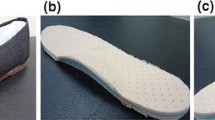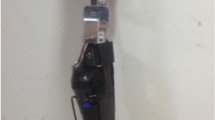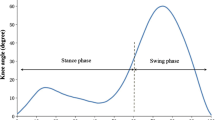Abstract
Although arch support orthotics are prescribed for knee osteoarthritis (OA) patients in clinics, the biomechanical effects of such devices are not fully clear. This study conducts an experimental investigation to evaluate the short-term effects of shoes with arch support insoles on the gait patterns of patients with knee OA during level walking. Twelve adults with knee OA were recruited, and biomechanical data were measured under three test conditions: walking barefoot, walking in shoes, and walking in shoes and insoles. Participants’ gait patterns were recorded and analyzed using a motion analysis system, Kistler force plates, and EVaRT software. Walking in shoes with insoles significantly increased the peak knee flexion angle and the peak dorsiflexion and external rotation angles of the ankle, but reduced the peak ankle internal rotation angle compared to those for walking barefoot. Both walking in shoes with insoles and walking in shoes significantly reduced the toe-out angle compared to that for walking barefoot. However, no significant difference was observed in the peak knee varus moment. The results suggest that the foot insoles and shoes tested in this study might have influenced the ankle joint in OA patients. In view of the significantly decreased toe-out angle of the foot and increasing trend in the knee varus moment, the use of shoes with insoles may be unsuitable for knee OA patients.







Similar content being viewed by others
References
Guccione, A. A., Felson, D. T., & Anderson, J. J. (1990). Defining arthritis and measuring functional status in elders: methodological issues in the study of disease and physical disability. American Journal of Public Health, 80, 945–949.
Brinkmann, J. R., & Perry, J. (1985). Rate and range of knee motion during ambulation in healthy and arthritic subjects. Physical Therapy, 65, 1055–1060.
Kaufman, K. R., Hughes, C., Morrey, B. F., Morrey, M., & An, K. N. (2001). Gait characteristics of patients with knee osteoarthritis. Journal of Biomechanics, 34, 907–915.
Williams, M. E., & Hadler, N. M. (1983). The illness as the focus of geriatric medicine. New England Journal of Medicine, 308, 1357–1360.
Frost, H. (1994). Perspectives: a biomechanical model of the pathogenesis of arthroses. Anatomical Record, 240, 19–31.
Hurwitz, D. E., Ryals, A. B., Case, J. P., Block, J. A., & Andriacchi, T. P. (2002). The knee adduction moment during gait in subjects with knee osteoarthritis is more closely correlated with static alignment than radiographic disease severity, toe out angle and pain. Journal of Orthopaedic Research, 20, 101–107.
Schipplein, O. D., & Andriacchi, T. P. (1991). Interaction between active and passive knee stabilizers during level walking. Journal of Orthopaedic Research, 9, 113–119.
Crenshaw, S. J., Pollo, F. E., & Calton, E. F. (2000). Effects of lateral-wedged insoles on kinetics at the knee. Clinical Orthopaedics and Related Research, 375, 185–192.
Hunt, M. A., & Birmingham, T. B. (2006). Associations among knee adduction moment, frontal plane ground reaction force, and lever arm during walking in patients with knee osteoarthritis. Journal of Biomechanics, 39, 2213–2220.
Sasaki, T., & Yasuda, K. (1987). Clinical evaluation of the treatment of osteoarthritic knees using a newly designed wedged insole. Clinical Orthopaedics and Related Research, 221, 181–187.
Kerrigan, D. C., Lelas, J. L., Goggins, J., Merriman, G. J., Kaplan, R. J., & Felson, D. T. (2002). Effectiveness of a lateral-wedge insole on knee varus torque in patients with knee osteoarthritis. Archives of Physical Medicine and Rehabilitation, 83, 889–893.
Kakihana, W., Akai, M., Nakazawa, K., Takashima, T., Naito, K., & Torii, S. (2005). Effects of laterally wedged insoles on knee and subtalar joint moments. Archives of Physical Medicine and Rehabilitation, 86, 1465–1471.
Shimada, S., Kobayashi, S., Wada, M., Uchida, K., Sasaki, S., Kawahara, H., et al. (2006). Effects of disease severity on response to lateral wedged shoe insole for medial compartment knee osteoarthritis. Archives of Physical Medicine and Rehabilitation, 87, 1436–1441.
Butler, R. J., Marchesi, S., Royer, T., & Davis, I. S. (2007). The effect of a subject-specific amount of lateral wedge on knee mechanics in patients with medial knee osteoarthritis. Journal of Orthopaedic Research, 25, 1121–1127.
Franz, J. R., Dicharry, J., Riley, P. O., Jackson, K., Wilder, R. P., & Kerrigan, D. C. (2008). The influence of arch supports on knee torques relevant to knee osteoarthritis. Medicine and Science in Sports and Exercise, 40, 913–917.
Lequesne, M. G., Mery, C., Samson, M., & Gerard, P. (1987). Indexes of severity for osteoarthritis of the hip and knee: validation-value in comparison with other assessment tests. Scandinavian Journal of Rheumatology, 16, 85–89.
Hochberg, M. C., Altman, R. D., Brandt, K. D., Clark, B. M., Dieppe, P. A., Griffin, M. R., et al. (1995). Guidelines for the medical management of osteoarthritis. Part II. Osteoarthritis of the knee. American College of Rheumatology. Arthritis and Rheumatism, 38, 1541–1546.
ORTHOTRAK Reference Manual (2001). Santa Rosa, CA: Motion Analysis Corporation.
Stacoff, A., Reinschmidt, C., Nigg, B. M., Van den Bogert, A. J., Lundberg, A., Denoth, J., & Stussi, E. (2000). Effects of foot orthoses on skeletal motion during running. Clinical Biomechanics, 15, 54–64.
Nester, C. J., Van der Linden, M. L., & Bowker, P. (2003). Effect of foot orthoses on the kinematics and kinetics of normal walking gait. Gait Posture, 17, 180–187.
Feuerbach, J. W., Grabiner, M. D., Koh, T. J., & Weiker, G. G. (1994). Effect of an ankle orthosis and ankle ligament anesthesia on ankle joint proprioception. American Journal of Sports Medicine, 22, 223–229.
Nigg, B. M., Nurse, M. A., & Stefanyshyn, D. J. (1999). Shoe inserts and orthotics for sport and physical activities. Medicine and Science in Sports and Exercise, 31, S421–S428.
Nawoczenski, D. A., & Ludewig, P. M. (1999). Electromyographic effects of foot orthotics on selected lower extremity muscles during running. Archives of Physical Medicine and Rehabilitation, 80, 540–544.
Chang, A., Hurwitz, D., Dunlop, D., Song, J., Cahue, S., Hayes, K., & Sharma, L. (2007). The relationship between toe-out angle during gait and progression of medial tibiofemoral osteoarthritis. British Medical Journal, 66, 1271–1275.
McClay, I., & Manal, K. (1999). Three-dimensional kinetic analysis of running: significance of secondary planes of motion. Medicine and Science in Sports and Exercise, 31, 1629–1637.
Eng, J. J., & Pierrynowski, M. R. (1994). The effect of soft foot orthotics on three-dimensional lower-limb kinematics during walking and running. Physical Therapy, 74, 836–844.
Nigg, B. M., Cole, G. K., & Nachbauer, W. (1993). Effects of arch height of the foot on angular motion of the lower extremities in running. Journal of Biomechanics, 26, 909–916.
Wen, D. Y., Puffer, J. C., & Schmalzried, T. P. (1997). Lower extremity alignment and risk of overuse injuries in runners. Medicine and Science in Sports and Exercise, 29, 1291–1298.
Reinschmidt, C., van Den Bogert, A., Murphy, N., Lundberg, A., & Nigg, B. (1997). Tibiocalcaneal motion during running, measured with external and bone markers. Clinical Biomechanics, 12, 8–16.
Acknowledgments
This project was partially supported by a National Health Research Institutes Grant (NHRI-EX97-9617EI).
Author information
Authors and Affiliations
Corresponding author
Rights and permissions
About this article
Cite this article
Lou, SZ., Su, FC. & Chen, YC. Effects of Arch Support Insoles on Gait Patterns of Patients with Knee Osteoarthritis. J. Med. Biol. Eng. 35, 202–208 (2015). https://doi.org/10.1007/s40846-015-0021-z
Received:
Accepted:
Published:
Issue Date:
DOI: https://doi.org/10.1007/s40846-015-0021-z




